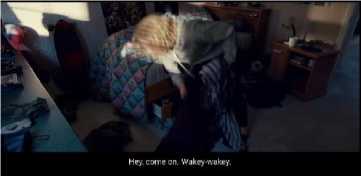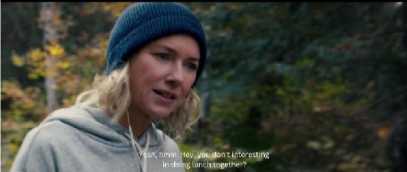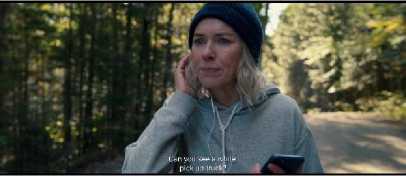Directive Illocutionary Acts of the Characters’ Utterances in “The Desperate Hour” Movie
on

p-ISSN: 2528-5076, e-ISSN: 2302-920X
Terakreditasi Sinta-3, SK No: 105/E/KPT/2022
Vol 26.4. Nopember 2022: 321-328
Ni Wayan Alanis Nadyasti Puranjani, I Made Rajeg Udayana University, Denpasar, Bali, Indonesia Correspondence email: maranisu@gmail.com, made_rajeg@unud.ac.id
Article Info
Submitted: 6th June 2022
Revised: 8th October 2022
Accepted: 16th October 2022
Publish: 30th November 2022
Keywords: character directive illocutionary act; movie; utterance
Corresponding Author:
Ni Wayan Alanis Nadyasti
Puranjani, email:
DOI:
Abstract
This study aims to describe the types of utterances of directives illocutionary act and the illocutionary forces of the characters’ utterances in “The Desperate Hour” movie. The form of data being taken is the characters’ utterances containing directive illocutionary acts. They were analyzed using the theory of speech acts proposed by Searle. It applies the descriptive qualitative method with the note-taking technique. The findings show that the interrogative and imperative types of utterances indicating directive illocutionary acts are applied in the movie. Whereas, the declarative utterances were not applied. The directives illocutionary acts show seven illocutionary forces, they are asking, commanding, inviting, begging, suggesting, requesting, and interrogating.
INTRODUCTION
Communication is crucial in people’s daily lives. People use language to communicate information and express their ideas, such as when they request, order, thank, promise, refuse, assert, and treat. A language is a set of rules that allows speakers to convert information from their surroundings into sound, (Gumperz, 1971). A language, according to Wardaugh (1998), is a system of arbitrary vocal sounds utilized for human communication. Lyons (1981) defined languages are the primary communication systems used by certain groups of people within the community in which they live. Moreover, people do
not just speak things when they communicate their ideas; they also act with their words. According to Thomas (1995), people use indirect strategies to make their speech more interesting, to achieve goals that differ from their partners, or to increase the force of the message communicated. However, it is beneficial to understand the circumstances surrounding the speaker and listener. Every conversation requires context. According to Levinson (1983), pragmatics is the study of the grammaticalized or encoded in the structure of a language, the relation between a language and context. Whereas, Peccei (1999) stated pragmatics
focuses on those characteristics of meaning that cannot be predicted only by linguistic knowledge and takes into account information about the physical and social world. Furthermore, according to Griffiths (2006), pragmatics is the study of how senders and addressees use context to expand on a literal meaning in communication. Mey (1993) stated that one should not believe a speech act is taking place until one has considered, or possibly created the appropriate context. This type of action is known as a speech act in pragmatics. According to Yule (1996), a speech act is a theory that examines an action accomplished through utterance. Moreover, Aitchison (2003) describes speech act as a collection of utterances that behave in a manner similar to actions. Speech act refers not only to the speaker's words but also to the speaker's intentions toward the listeners, (Bach, 1994). Communication in the speaking act requires not just understanding the meaning of words in an utterance but also understanding what speakers mean by their utterance. It means that to grasp what the speaker is saying, context is required as part of communication. Furthermore, Leech (1983) states when a speaker delivers an utterance, he engages in three categories of acts: locutionary, illocutionary, and perlocutionary.
Austin (1962) stated that the three sorts of speech acts are the locutionary act, illocutionary act, and perlocutionary act. The act of uttering anything is known as a locutionary act. The act of doing something is referred to as an illocutionary act. An illocutionary act is one in which the utterance is made to convey a certain message. It includes requests, questions, orders, advice, etc. The act of affecting someone is known as a perlocutionary act. Accordingly, the influence of the speaker’s statement can cause someone else to do what the speaker says.
According to Austin (1962), the illocutionary act is the act of doing something. Then, according to Searle (1979), the illocutionary act is separated into five types. They are representatives, directives, commissive, declarative, and expressive. Here are the explanations and examples of directives illocutionary acts. a. Directives
This type is an illocutionary act that tries by the speaker to make the listener do something. They speak directly to the listener about what they want. It is usual to see it with performative verbs like requesting, commanding, demanding, questioning, asking, advising, suggesting, begging, ordering, etc.
Examples:
-
1. Give me a cup of a tea, please. (Ordering)
-
2. Could you pick up my son?
(Requesting)
-
3. Do you want to come to my house?
(Inviting)
According to Searle (1979), he classified types of illocutionary acts are; representatives, directives, commissive, declarative, and expressive. The speaker should utter anything with intended meanings to the hearer based on the situation and true condition when conducting an illocutionary act. Studying illocutionary acts might help us gain a better comprehension of the speaker’s utterance in a certain circumstance, such as a movie. Characters in movies, such as those in The Desperate Hour movie, always present a story that persuades the viewer to watch it. The purpose why this study was conducted is in everyday phenomena, people often use the form of a question or interrogative, however in fact, they do not just ask, but give a command for example ‘could you close the door?’ this is an interrogative form and behind this sentence, there is the meaning of the command which is the speaker wants the door closed. Thus, if
someone asks something, it does not mean he or she just asking, but has other meanings such as commands or others. There are several studies that support the background of the study carried out on this phenomenon. Utami (2018) analyze the directive illocutionary acts and the forces of the modes of utterance in the film. The descriptive qualitative method was used in this study. The data were analyzed using two theories: the speech acts theory developed by (Searle, 1979) and the context of the situation theory developed by (Halliday, 1989). There were ten declarative data, ten interrogative data, and five imperative data that had been analyzed. Commanding, inviting, requesting, advising, and begging was the forces of the modes of utterance discovered. This study provided a brief explanation of the data.
According to (Oktaviani et al., 2021) in their article recognize the most common sorts of directive illocutionary acts utilized in Me Before You. To define and assess the most dominating illocutionary act in Me Before You, the researcher used quantitative and qualitative methodologies. The results revealed that there are six different sorts of illocutionary acts in this film. There are commanding, requesting, admonishing, urging, and ordering.
Subsequently, an article from (Suryaningsih, 2014) aimed to obtain the type of directive illocutionary acts found in the manuscript, and the directive illocutionary acts of speech also could support the emergence of a listener response (Leech, 1983) theory is the main theory used to classify directive illocutionary acts. This study only appears to look at directive illocutionary acts. According to Leech, there are four types of directive illocutionary acts: tell, ask, advise, and invite. According to the findings of this study, 9 data points were
collected for type directive illocutionary acts.
An article by Putra & Sedeng (2022) aimed to determine the classification and force of the speaker's utterances found in the film. The data was gathered using documentation and note-taking techniques, and it was analyzed using the descriptive qualitative method. The theory employed in this study is that of (Bach & Harnish, 1979) and the illocutionary force indicating device proposed by (Yule, 1996). All of the direct directive acts were discovered during this research. Except for indirect questions, only five types of indirect directive acts were discovered. The illocutionary force of the found directive acts is requesting, asking, forbidding, permitting, commanding, warning, prohibiting, ordering, and suggesting.
Then, an article from Mahendra (2018) identifying the direct and indirect directive types of illocutionary acts and analyzing the meaning of the utterances. The data were analyzed using descriptive qualitative method and the theory used were proposed by (Bach & Harnish, 1979) and (Hymes, 1972). The relevance of this study has the same purpose to find out the meaning or illocutionary forces in the movie. Furthermore, Pratama & Juniartha (2021) in their article examine the types of directive illocutionary acts and identify the function of directive illocutionary acts. Descriptive qualitative method were used in this study and the theory used were proposed by (Searle, 1979) and (Leech, 1983). The function of directive illocutionary acts were relevant as illocutionary forces that conducted in this study.
However, this study merely analyzed the directives illocutionary act and illocutionary forces that appear in the movie. Consequently, this study was conducted to find out the types of utterances on a directive illocutionary act and illocutionary forces which is uttered
by the characters of The Desperate Hour movie.
Based on the background of the study above, the writers formulate two problems of the study are as follows: What types of utterances on directive illocutionary acts are applied by the characters in The Desperate Hour movie?, What illocutionary forces are implied in the utterances used by the characters in The Desperate Hour movie?
METHOD AND THEORY
To conduct scientific writing, it is necessary to follow a systematic way and scientific procedures to achieve a valid result. The research method used in this study can be divided into four parts; they are (1) data source, (2) method and technique of collecting data, (3) method and technique of analyzing data, and (4) method and technique of presenting analysis which is explained further in the following sections:
In this study, the data of the study were taken from The Desperate Hour movie. It is a 2021 thriller film directed by Phillip Noyce. It stars Naomi Watts as a woman who is desperately racing to save her child after police place her hometown on lockdown due to an active shooter incident. The film was shot in the North Bay area of Ontario in 2020. It premiered at the 2021 Toronto International Film Festival. The Desperate Hour was theatrically released by Roadside Attractions and Vertical Entertainment on February 25, 2022. The movie tells a story about in a tiny village, a mother who has lost her husband lives with her teenage son. While out for a jog in the woods, she discovers her town in chaos due to a shooting at her son’s school.
The data were collected using the qualitative method and note-taking technique. Furthermore, there were some steps of data collection. First, the movie was watched. Second, note-taking of the dialogue. Furthermore, the directive
illocutionary acts were noted and highlighted. When the data were collected, they were classified based on the types of utterances on directives illocutionary act. In analysis, the data were collected and then selected and the most potential related ones were descriptively analyzed and categorized based on the types of utterances on directive illocutionary acts, they are asking, requesting, ordering, commanding, begging, pleading, praying, defying, permitting, advising, and inviting. Moreover, to classify the data based on the types of the illocutionary act and find one which was a directive illocutionary act, the speech act theory proposed by (Searle, 1979) was used. In presenting the analysis, the data were typed in bold and elaborated in paragraphs narratively.
RESULT AND DISCUSSION
This chapter contains the result and discussion that will be discussed, which are the data source taken from “The Desperate Hour” movie. The result is Asking, Commanding, Inviting, Begging, Suggesting, Requesting, Interrogating.
Asking means to ask someone a question or make a request for an answer. The example of asking can be seen from this data.

Amy : You’ve been up on that phone all night, haven’t you?
In the data above, the participants are Amy and Noah, they are mother and son. Amy is asking Noah about staying up late or not because Noah did not open the
bedroom door. She called Noah many times but no answer at all from him. She suspected why he did not wake up even though it was noon and she was afraid that Noah is late for school. Amy asked about staying up late to Noah and want to make sure that Noah’s answer is yes. She wants Noah to confess that he stayed up late last night. The type of utterance “You stay up late playing cell phone, haven’t you?” is interrogative and the illocutionary force is asking someone. It is directive illocutionary acts because Amy wants Noah to answer her question and confess.
Commanding means telling someone else to do something that we want or what we ordered. The example of commanding can be seen from this data.

Amy : Come on. Wakey, wakey.
In the data above, the participants are Amy and Noah, they are mother and son. Amy is telling Noah to get up to school. She cleans Noah’s room while waking up Noah. Noah does not wake up and still sleeps using a blanket. Amy was afraid that Noah is late for school, then she gave the commands to Noah to get up from his mattress. However, Noah said he would not go to school because he was too lazy to wake up, and he was still very sleepy. The type of utterance “Come on. Wakey, wakey.” is imperative and the illocutionary force is commanding someone to do something. It is directive illocutionary acts because Amy wants Noah to get up from bed and get ready for school.
3. Inviting
Inviting means asking people to come to an event that has been determined by the invitee. The example of inviting can be seen from this data.

Greg : Yeah, hmm. Hey, you don’t
interesting in doing lunch together?
In the data above, the participants are Greg and Amy, they are co-workers at the state tax office. Greg is calling Amy about their business and ends up asking Amy to do lunch together. He asking about that because he has some feelings for Amy. At that time Amy was exercising in the wood and received a call from Greg. Before hanging up the phone, Greg asks Amy about having lunch together. However, Amy politely refused Greg’s invitation because she was busy running in the woods and wanted to talk about it later. The type of utterance “you don’t interesting in doing lunch together?” is interrogative and the illocutionary force is inviting someone. It is directive illocutionary acts because Greg invites Amy to have lunch and hopes that Amy accepts the invitation.
4. Begging
Begging means asking someone else to help or do something that you want. The example of begging can be seen in this data.

Amy : I’m on my way home.
Please, just call me.
In the data above, the participants are Amy and Noah, they are mother and son. Amy is calling Noah many times but he did not answer it. She is worried about her son due to the shooting at his school. After calling so many times, Amy decided to leave a voice mail to Noah. She tells Noah that she is on her way home. She cannot go to Noah’s school because she is in the wood and way too far from school. Amy wanted after Noah received her voice mail, Noah immediately calls Amy back and tell the situation. The type of utterance “Please, just call me” is imperative and the illocutionary force is begging someone. It contains directive illocutionary acts because Amy begging to hope Noah to tell the situation at school and call her back.
Suggesting means offering someone a concept or a plan to think about and informing someone about something that might be helpful. The example of suggesting can be seen from this data.

911 Officer : I’m sorry. I don’t have that information, Amy. But, if you hear from your son, try to contact us again.
In the data above, the participants are the 911 officer and Amy. There was a shooting accident at her son’s school. Amy was asking for information about what is going on with her son to the 911 officer and she wanted to make sure did her son went to school or not. However, the 911 officer did not have any information about her son and suggest
she contact the 911 officer if she gets information about her son’s condition. The utterance “But, if you hear from your son, try to contact us again.” contains a directive illocutionary act and the type of utterance is imperative. The illocutionary force is suggesting someone. In this case, the 911 officer suggests Amy waits for some news from her son, and immediately tell the 911 officer when she got news from her son.
Requesting means that we ask someone for something or ask them to do something. The example of requesting can be seen from this data.

Amy : Can you see a white pickup truck?
In the data above, the participants are Amy and Jerry. Amy is the owner of the house and Jerry is a handyman who will repair the walls at Amy’s house. Jerry was calling Amy to inform her that he was at her house, however, Amy was not there. She was still in the woods. She was panicked because her son, Noah his whereabouts were still unknown. So, Amy asked Jerry if he was still there and she requested Jerry to see a white pickup in her house’s driveway. The white pickup truck belongs to Noah, he usually goes to school using that truck. Jerry answered that he did not see the truck, but he only saw a car there. The utterance “Can you see a white pickup truck?” is interrogative and it contains a directive illocutionary act. The illocutionary force is requesting someone to do something. In this case, Amy asked and wanted Jerry to do something and Jerry accept to do it.
Interrogating refers to asking someone a question or examining someone through oral questions. Usually, the speaker urges the hearer in purpose to answer the question honestly. The example of interrogating can be seen from this data.

Detective Ed Paulson : Guns. Do you keep any guns in your home?
In the data above, the participants are detective Ed Paulson and Amy. When Amy talked to the 911 officer, suddenly detective Ed Paulson wanted to talk with Amy. He wanted to ask some questions to Amy about her son, Noah because Noah was involved in the shooting at his school. Subsequently, detective Ed Paulson interrogated Amy with this utterance “Do you keep any guns in your home?”. He wanted to know about it because the shooter has not been found. Amy is required to speak honestly to detectives in order to help with police investigations. The utterance “Do you keep any guns in your home?” is interrogative and contains directive illocutionary acts. The illocutionary force is interrogating someone. In this case, detective Ed Paulson interrogated Amy and wanted Amy to answer the question honestly.
CONCLUSION
The study concluded that there were seven types of utterances on directives illocutionary acts applied in “The Desperate Hour” movie, they are
interrogative and imperative. None of the declarative types were found in the movie.
In terms of function, the illocutionary forces found in the movie were asking, commanding, inviting, begging, suggesting, requesting, and interrogating.
The suggestion for further research is expected to find out the function of directive illocutionary acts using the theory of the context of situation by Hymes.
REFERENCES
Aitchison, J. (2003). Words in the Mind:
An Introduction to the Mental
Lexicon (3rd ed.). Blackwell.
Austin, J. L. (1962). How to Do Things with Words. Oxford University Press.
Bach, K. (1994). Meaning, Speech Acts, and Communication. Harvester
Wheatsheaf.
Bach, K., & Harnish, R. M. (1979).
Linguistic Communication and Speech Acts. MIT Press.
Griffiths, P. (2006). An Introduction to English Semantics and Pragmatics. Edinburgh University Press Ltd.
Gumperz, J. J. (1971). Language in
Social Groups (1st ed.). Stanford University Press.
Halliday, M. A. K. (1989). Language, Context, and Text: Aspect of Language in a Social-Semiotic Perspective. Deakin University.
Hymes, D. (1972). Directions in Sociolinguistics: The Ethnography of Communication. Holt, Rinehart and Winston, Inc.
Leech, G. (1983). Principles of Pragmatics. Longman.
Levinson, S. (1983). Pragmatics.
Cambridge University Press.
Lyons, J. (1981). Language, Meaning and Context. Cambridge University Press.
Mahendra, G. A. (2018). Direct and Indirect Directive Illocutionary Acts in the Movie “Penguin of Madagascar.” Jurnal Humanis, Fakultas Ilmu Budaya, 22.1.
https://doi.org/10.24843/JH.2018.v 22.i01.p38
Mey, J. L. (1993). Pragmatics: An Introduction. Blackwell.
Oktaviani, A., Syafitri, D., & Syafrizal. (2021). Directive Illocutionary Acts in Me Before You Movie. Linguistic, English Education and Art (LEEA), 4.2.
https://doi.org/10.31539/leea.v4i2.2 255
Peccei, J. S. (1999). Pragmatics. Taylor & Francis Limited.
Pratama, S. A. S., & Juniartha, I. W. (2021). An Analysis Of Directive Illocutionary Act In The Movie Maleficent. Journal of Language and Applied Linguistics, 02.1.
https://dx.doi.org/10.22334/traverse .v2i1
Putra, I. P. W. A., & Sedeng, I. N. (2022). Directive Illocutionary Acts Found in the Movies 21 and 22 Jump Street. Jurnal Humanis, Fakultas Ilmu Budaya, 26.2.
Searle, J. R. (1979). Expression and Meaning: Studies in the Theory of Speech Acts. Cambridge University Press.
Suryaningsih, A. A. I. A. (2014). The Directive Illocutionary Acts in “To Kill a Mockingbird” Screenplay by Horton Foote. Jurnal Humanis, Fakultas Ilmu Budaya, 9.1.
Thomas, J. (1995). Meaning in Interaction: An Introduction to Pragmatics. Longman.
Utami, P. K. (2018). Directive Illocutionary Acts with Special Reference to Pitch Perfect. Jurnal Humanis, Fakultas Ilmu Budaya, 22.1.
https://doi.org/10.24843/JH.2018.v
22.i01.p33
Wardaugh, R. (1998). An Introduction to
Sociolinguistics (3rd ed.).
Blackwell.
Yule, G. (1996). Pragmatics. Oxford University Press.
Discussion and feedback